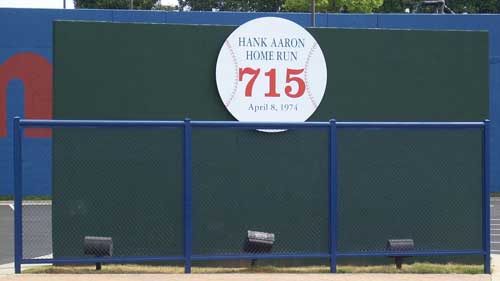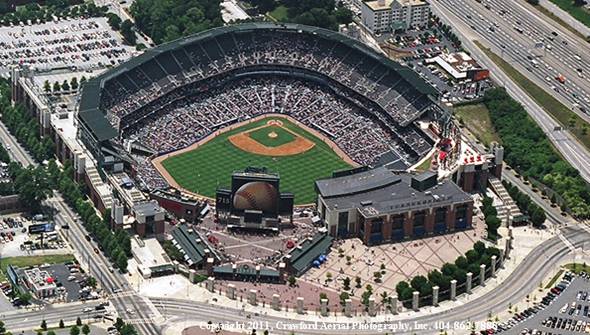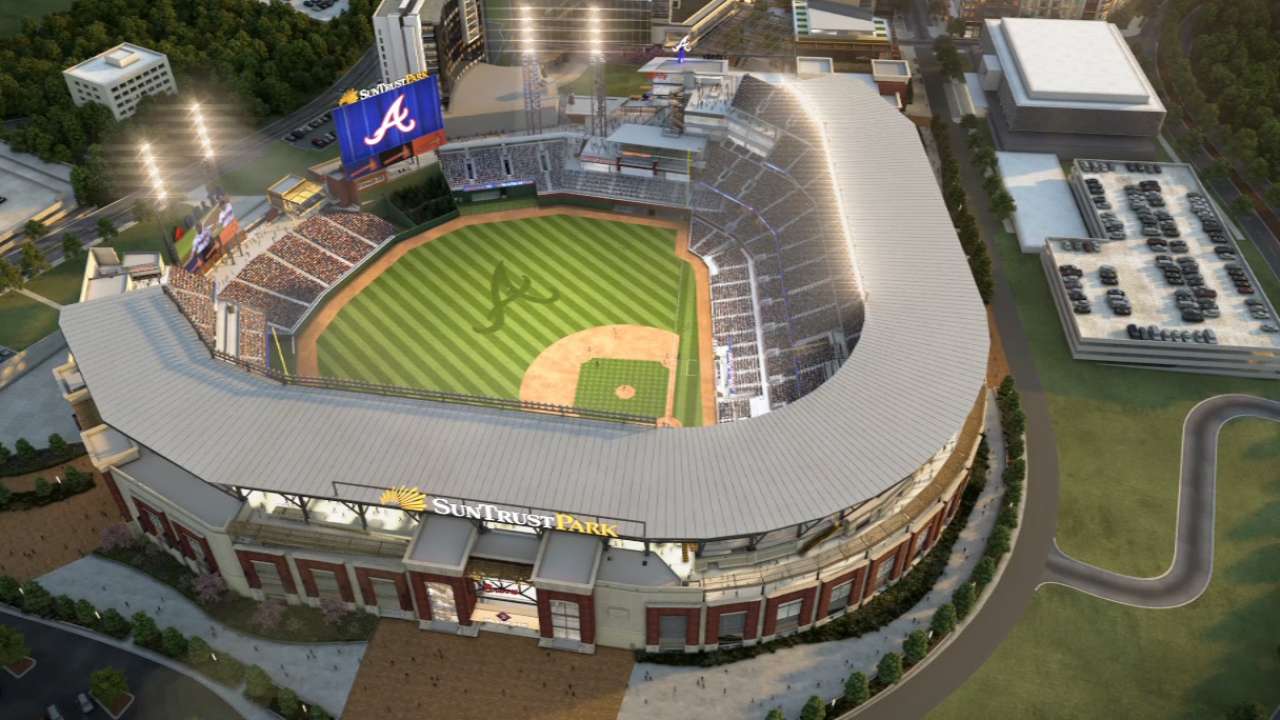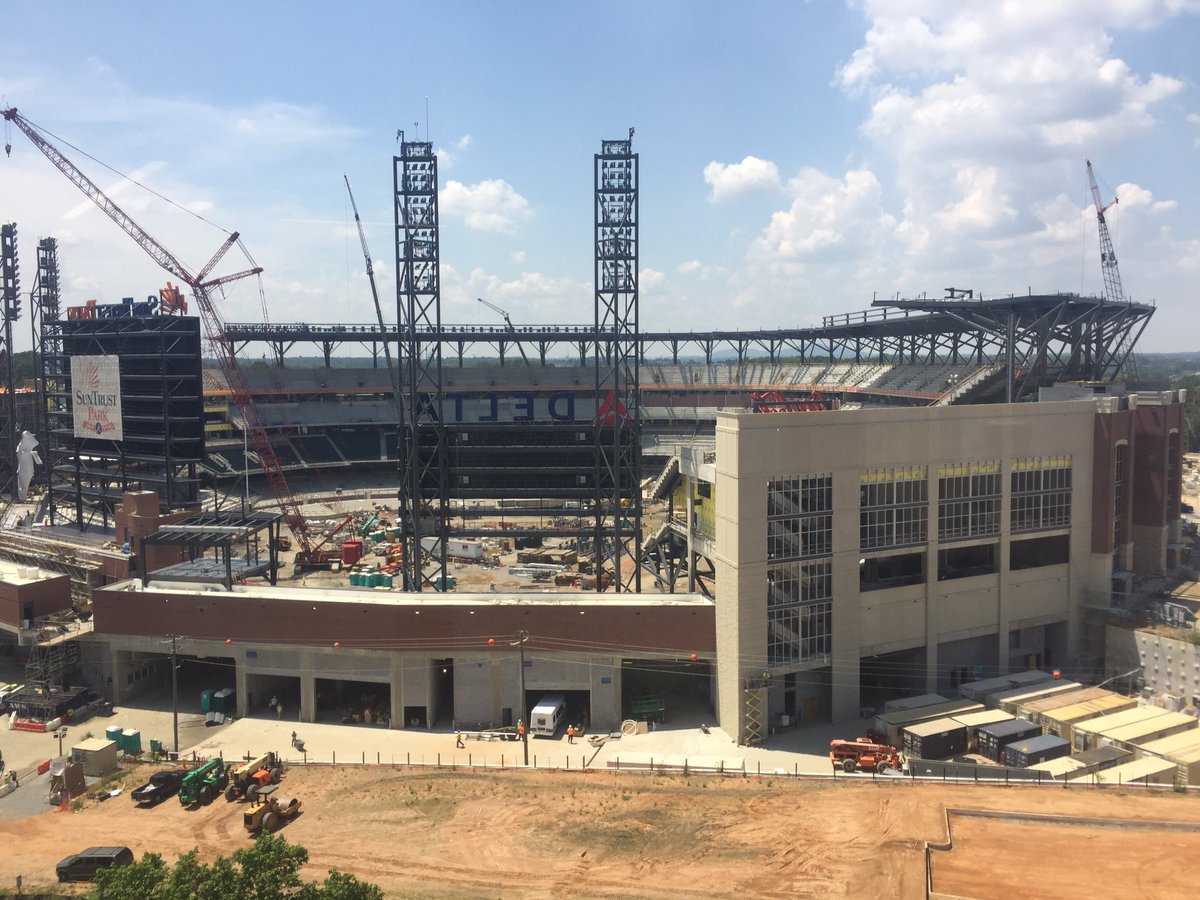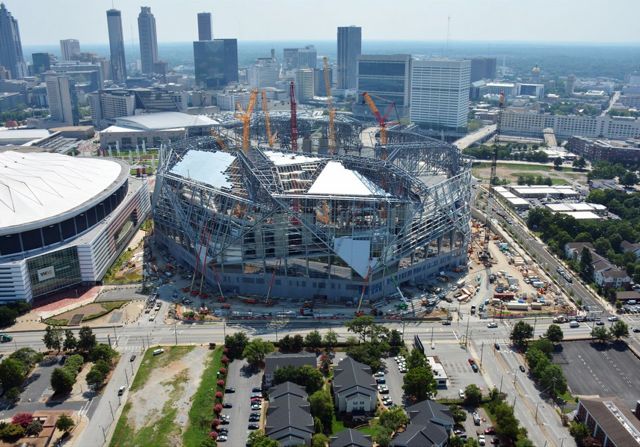The expansion soccer team Atlanta United FC will play their 1st competitive match against my New York Red Bulls at Grant Field on the Georgia Tech campus, next Sunday, March 5, 2017, at 7:30 PM.
Before You Go. Being well south of New York, Atlanta is usually warmer than we are. It also gets rather humid. They don't call it "Hot-lanta" just for its nightlife. However, this being early March, heat and humidity shouldn't be an issue.
Check the website of the
Atlanta Journal-Constitution (used to be 2 papers, now 1) before you go. Temperatures are projected as being in the mid-60s on Sunday afternoon, and the low 50s at night. You might need a light jacket for the game, but not for most of the day.
Although Georgia, a.k.a. The Heart of the South, seceded from the Union in 1861, it was readmitted in 1870. You do not need a passport, and you don't need to change your U.S. dollars into Confederate money. And it's in the Eastern Time Zone, so you don't have to fiddle with your watch or your phone clock. Do keep in mind, though: They think you talk as funny as you think they do.
Tickets. The official capacity of Grant Field is 55,000, although this opener will probably be the only game for which the upper deck is opened. Tickets are still available for this game. (Save your jokes about other Atlanta teams' attendance.)
I can't get any listing of where away supporters will be placed. However, since the main home supporters' clubs will be in the north end, Sections 112 to 119, it makes sense that the away supporters would be put all the way across the field, in the south end, Sections 131 to 136. These seats will be $40.
Getting There. It's 868 miles from Times Square in New York to Five Points, Atlanta's center of attention. Google Maps says the fastest way from New York to Atlanta by road is to take the Holland Tunnel to Interstate 78 to Harrisburg, then I-81 through the Appalachian Mountains, and then it gets complicated from there.
No, the best way to go, if you must drive, is to take the New Jersey Turnpike/I-95 all the way from New Jersey to Petersburg, Virginia. Exit 51 will put you on I-85 South, and that will take you right into Atlanta.
You'll be in New Jersey for about an hour and a half, Delaware for 20 minutes, Maryland for 2 hours, inside the Capital Beltway (Maryland, District of Columbia and Virginia) for half an hour if you're lucky (and don't make a rest stop anywhere near D.C.), Virginia for 3 hours, North Carolina for 4 hours, South Carolina for about an hour and 45 minutes, and Georgia outside I-285 (the beltway known as the Perimeter, the Atlanta Bypass or "the O around the A") for an hour and a half.
Throw in traffic in and around New York at one end, Washington in the middle, and Atlanta at the other end, and we're talking 16 hours. Throw in rest stops, preferably in Delaware, near Richmond, near Raleigh, and in South Carolina, and it’ll be closer to 19 hours. Still wanna drive? Didn't think so.
Take the bus? Greyhound has plenty of service between the two cities, and a round-trip fare can be as low as $115. But it can be up to 24 hours each way. At least the station is downtown, at 232 Forsyth Street at Brotherton Street, by the Garnett station on the subway.
Take the train? Amtrak's New York-to-New Orleans train, the
Crescent, leaves Penn Station at 2:15 PM and arrives at 8:13 AM the next morning. Going back, it leaves at 8:04 PM (so you'd have to stay overnight) and arrives back in New York at 1:46 the next afternoon. The round-trip fare is $304. It's as long as driving and riding the bus, and costs a lot more than the bus. The station is at 1688 Peachtree Street NW at Deering Road, due north of downtown. From there, take the 110 bus into downtown.
Perhaps the best way to get from New York to Atlanta is by plane? If you book now, United Airlines can get you from Newark Liberty International Airport to Hartsfield-Jackson International Airport for $810 round-trip. True, that's a bit expensive than the train, but under 3 hours each way beats the hell out of 18 or 24. The Metropolitan Atlanta Rapid Transit Authority (MARTA) Gold Line or Red Line subway from Hartsfield-Jackson to Five Points takes just half an hour.
(The airport is named for 2 Mayors. William B. Hartsfield served from 1942 to 1962, and got the airport built. Maynard H. Jackson Jr. was the city's 1st black Mayor, serving from 1974 to 1982, and again from 1990 to 1994, and he got a new terminal built at the airport.)
Once In the City. When you get to your hotel in Atlanta (and, let's face it, if you went all that way, you're not going down for a single 3-hour game and then going right back up the Eastern Seaboard), pick up a copy of the
Journal-Constitution. It's a good paper with a very good sports section.
The New York Times may also be available, but, chances are, the
Daily News and the
Post won't be.
Founded in 1837, and originally named "Terminus" because it was established as a railroad center, but later renamed because the railroad in question was the Atlantic-Pacific Railroad, Atlanta is a city of about 472,000 people (slightly less than Staten Island), in a metropolitan area of about 6.4 million (still less than 1/3rd the size of the New York Tri-State Area). The sales tax in Georgia is just 4 percent, but it's 5 percent in the City of Atlanta.
The State House
Be advised that a
lot of streets are named Peachtree, which can confuse the hell out of you. Even worse, the city uses diagonal directions on its streets and street signs, much like Washington, D.C.: NW, NE, SE and SW. The street grid takes some odd angles, which will confuse you further. Five Points -- Peachtree Street, Marietta Street & Edgewood Avenue -- is the centerpoint of the city.
A building boom in the 1980s gave the city some pretty big skyscrapers, so, while it won't seem quite as imposing as New York or Chicago, it will seem bigger than such National League cities as Cincinnati and St. Louis. The building currently named Bank of America Plaza, a.k.a. the Pencil Building because of its shape, is the tallest in the State of Georgia, at 1,033 feet. It stands at 600 Peachtree Street NE at North Avenue.
ZIP Codes in Georgia start with the digits 30 and 31, with Atlanta and its suburbs using 300 to 307. The Area Code for Atlanta is 404, with 770 surrounding it, and 678 overlaid.
MARTA's 3-stripes logo of blue, yellow and orange is reminiscent of New Jersey Transit's blue, purple and orange. A single trip on any MARTA train is $2.50, now cheaper than New York's. A 10-trip is no bargain at $25. The subway started running with tokens in 1979, and switched to farecards known as Breezecards in 2006.
Atlanta has always been the cultural capital of the South, particularly of the "New South." In the 1950s, Mayor Hartsfield, knowing that he couldn't get investors in his city if it was believed to be racist, billed it as "the City Too Busy to Hate." And Atlanta is a majority-black city. Nevertheless, it is still in Georgia, which is still the South. There's still old touches, including the fixation on
Gone With the Wind, and the fact that the State Flag, even after several redesigns, still resembles the actual flag of the Confederate States of America, "the Stars and Bars" (not the "Southern Cross," that was the Confederate Battle Flag).
Going In. Until Mercedes-Benz Stadium is ready on July 30, Atlanta United will be playing at Bobby Dodd Stadium at Historic Grant Field, home football stadium of the Georgia Institute of Technology, a.k.a. Georgia Tech.
The official address is 150 Bobby Dodd Way, with the former address being 177 North Avenue NW (yeah, another one of those), about a mile and a half north of downtown. MARTA Gold or Red to North Avenue. If you drive in, parking is $10.
The oldest stadium in the NCAA's Football Bowl Subdivision (formerly Division I-A)? It sure doesn't look it, having been modernized several times since its opening over 100 years ago, on September 27, 1913. Bobby Dodd, who played at the University of Tennessee and coached at Georgia Tech (first as an assistant to Bill Alexander, then as head coach), is one of only 3 people elected to the College Football Hall of Fame as both a player and a coach.
The field runs north-to-south, and is natural grass, after having been Astroturf from 1971 to 1994. Previous soccer teams to play there were the Atlanta Apollos of the old North American Soccer League in 1973, and the Atlanta Beat of the Women's United Soccer Association in 2001.
College football's Peach Bowl was played there in 1968, '69 and '70. The NFL's Atlanta Falcons played a game there on October 5, 1969, against the Baltimore Colts, because the Braves unexpectedly qualified for the 1st-ever National League Championship Series against the Mets, and had dibs on what became Fulton County Stadium. (Atlanta lost both.)
Grant Field/Dodd Stadium, get up for Georgia Tech football,
with the skyline of downtown Atlanta in the background.
Food. This being the South, you could expect good eating and good hospitality. Unfortunately, Georgia Tech's website contains no information about concession stands at Dodd/Grant.
A website called
SportsWhereIAm.com suggests that the west stand, where the Tech sideline is during football games, has the best selection. This site and others recommend Sonny's Pit BBQ. They also recommend the Nutty Bavarian and The Malt Shoppe, and say that if you're on the east stand, "your options will be drastically reduced to Gridiron Grill or Domino's Pizza."
And, being a college stadium, beer is not sold there.
Team History Displays. What history? They're an expansion team playing their 1st competitive match. Any historic displays will be for Georgia Tech.
On February 10, however, 23 days before their real debut, Atlanta United announced their 1st retired number: 17, for their fans, the number representing the year of their debut. Josef Martínez, likely to be the team's starting striker, wore 17 the last 3 seasons for Turin club Torino (even though it is considered a bad luck number in Italy, much as 13 is in the English-speaking world), but he agreed to switch to Number 7, saying that the symbolism of retiring the number for the fans is bigger than himself, his teammates, his coaches, or any other individual.
Stuff. There will likely be a team store at the new stadium, but, since Tech controls this stadium, Atlanta United won't have one there. You may have to settle for small souvenir stands. The team is new, so there's no team videos or books about the team.
During the Game. Atlanta United are a brand-new team. They have not yet had a chance to build any rivalries. For the moment, the only other MLS teams in the former Confederate States are Orlando City and the Texas teams, FC Dallas and the Houston Dynamo. Perhaps their distaste for the North might lead them to one day not like the Red Bulls or NYCFC, and their distaste for the federal government might lead them to one day not like D.C. United.
But they don't want to mess up their reputations by starting a fight at their 1st game that counts. If you leave them alone, they'll almost certainly leave you alone.
AUFC do not yet have a mascot. They hold auditions for National Anthem singers, instead of having a regular singer. As you might guess, Braves fans conclude the National Anthem not with " …and the home of the brave" but " …and the home of the Braves!" Hopefully, AUFC fans will not also do this. Or that annoying Tomahawk Chop and its song, the War Chant: "Oh, oh-whoa-oh-oh… whoa-oh-oh… oh-whoa-oh-oh…"
Their main supporters' clubs sit in the north end, Sections 112 to 119. Footie Mob and Resurgence (the latter symbolizing the city's rebirth after the Civil War) are holdovers from the previous minor-league team, the Atlanta Silverbacks. Terminus Legion (named for the city's original name) started in 2014, to coincide with MLS' official announcement of the team's establishment. The Faction is a family-friendly group, and is less likely to be involved in traditional soccer "ultra" activities. (So, no profane chants.)
To the tune of "The Ants Go Marching" -- it's the same tune as "When Johnny Comes Marching Home," but they can't cite that, because it's a Union song from the Civil War -- Terminus Legion sings:
We are Atlanta, we hold it down, A-Town, A-Town!
We are Atlanta, we hold it down, A-Town, A-Town!
The city where the players play!
We ride on them things like every day!
We are Atlanta, and we hold it down!
Or, as we Red Bull fans sing, "Da-da, da-da, D.C. United takes it up the ass!"
To the tune of Atlanta-based OutKast's "Hootie Hoo," Footie Mob sings:
Hootie Hoo!
United on the left, United on my right!
Attacking all days, scoring always!
Hootie Hoo!
United on the left, United on my right!
Attacking all days, scoring always!
Hootie Hoo!
After the Game. You should have no trouble with AUFC fans on your way out. Atlanta does have a bit of a crime problem: While you'll probably be safe around the stadium and on the subway, you don't want to wander the streets late at night.
A good way to have fun would seem to be to find a bar where New Yorkers hang out. Unfortunately, the best ones I could come up with were all outside the city. Hudson Grille (sure sounds like a New York-style name), 6317 Roswell Road in Sandy Springs, is 15 miles north of Five Points. MARTA Red Line to Dunwoody, then transfer to Number 5 bus.
Mazzy's, at 2217 Roswell Road in Marietta, is the home of the local Jets fan club, but it's 20 miles north, and forget about reaching it by public transportation. The club also lists Bada Bing's, at 349 Decatur Street SE, just 1 stop east of Five Points on the MARTA Green Line (fitting), but they claim Mazzy's is their "perfect place." Meehan's Public House is also said to be a Jet fans' hangout. 227 Sandy Springs Place, at the CityWalk shopping center, just outside I-285. MARTA Red Line to Dunwoody, transfer to the 87 bus.
A Facebook page titled "Mets Fans Living In Atlanta" was no help. Your best bet may be to research hotel chains, to find out which ones New Yorkers tend to like, and meet up with fellow Metsophiles (or Metsochists) there.
A recent
Thrillist article on the best sports bars in each State listed The Midway Pub as the best in Georgia. It's about 3 1/2 miles east of downtown, at 552 Flat Shoals Avenue SE. Number 74 bus.
A few steps away from Grant Field, over the North Avenue Bridge (over I-75/85) at 61 North Avenue NW, highlighted by a huge neon letter V, is The Varsity. No visit to The A-T-L is complete without a stop at The Varsity. Basically, it’s a classic diner, but really good. Be careful, though: They want to keep it moving, much like the Soup Nazi on
Seinfeld and its real-life counterpart The Original Soup Man, and also Pat's Steaks in Philadelphia.
The place has a language all its own, and, when they ask, "What’ll you have?", being a Met fan, you do
not want to order what they call a Yankee Dog – or a Naked Dog, which, oddly, is the same exact thing: A hot dog whose only condiment is mustard (which hardly makes it "naked," but that's what they call it). Check out
this link, and you'll get an idea of what to say and what not to say.
If your visit to Atlanta is during the European soccer season, which is now moving toward its climax, you can watch your favorite clubs at the following locations:
* Arsenal, Manchester City and Leicester City: Brewhouse Cafe, 401 Moreland Avenue NE. MARTA Blue Line to Inman Park-Reynoldstown, then Bus 6 to Euclid & Moreland.
* Chelsea and Bayern Munich: Ri Ra, 1080 Peachtree Street, 2 miles north of downtown. MARTA Red or Gold Line to Midtown Transit Station. I've also heard that Bayern fans meet at Der Biergarten, 300 Marietta Street NW,just north of the stadium/arena complex. Bus 51.
* Liverpool: Meehan's Public House, 200 Peachtree Street. MARTA Red or Gold Line to Peachtree Center.
* Tottenham Hotspur: A different Meehan's, 232 19th Street NW, 3 miles north of downtown. MARTA Red or Gold Line to Arts Center, then a 20-minute walk. (You were expecting Atlanta + Spurs to = Brains? Yeah, surrrre.)
* Manchester United, Everton, Celtic and Barcelona: Fado Irish Pub, at The Shops Buckhead Atlanta, 273 Buckhead Avenue, 6 miles north of downtown. Bus 110.
* Real Madrid: The Olde Blind Dog, 705 Town Blvd NE, 9 miles northeast of downtown. MARTA Gold Line to Brookhaven, then Bus 25 to Peachtree Road & Town Blvd.
If you don't see your club listed here, your best bets are Brewhouse Cafe or Fado.
Sidelights. When the Thrashers moved to become the new Winnipeg Jets in 2011, it marked the 2nd time in 31 years that Atlanta had lost an NHL team. They still have teams in MLB, the NFL and the NBA, plus a Division I-A college which has been successful in several sports, the annual Southeastern Conference Championships for both football and basketball, an annual college football bowl game, the Peach Bowl -- and, now, MLS.
But that doesn’t make Atlanta a great sports town. All of their major league teams have tended to have trouble filling their buildings.
* Atlanta-Fulton County Stadium. Home to the Southern Association's Atlanta Crackers in their last season, 1965; to the Braves from 1966 to 1996; to the NFL Falcons from 1966 to 1991; and to the Atlanta Chiefs of the North American Soccer League (Champions 1968) from 1967 to 1973. Known simply as Atlanta Stadium until 1974, it was in what's now the parking lot north of Turner Field.
The old stadium hosted the World Series in 1991, 1992, 1995 and 1996, the last 3 games there being the Yankees' wins in Games 3, 4 and 5 of the '96 Series. It hosted NFC Playoff games in 1978 and 1991, the Peach Bowl from 1971 to 1991, the 2nd legs of the 1968 and 1971 NASL Finals hosted by the Chiefs, and 2 matches of the U.S. national soccer team: A win over India in 1968, and a win over China in 1977. It also hosted the Beatles shortly after its opening, on August 18, 1965.
In the Green Lot parking area north of the park, where Atlanta-Fulton County Stadium used to be, there is a chain-link fence about where the left-center-field fence was, and, at the approximate location of where it landed, then the Braves' bullpen, is the marker that used to be on the wall behind it, honoring Aaron’s record-breaking 715th career home run, hit on April 8, 1974.
Fulton County Stadium was known as "The Launching Pad." Put it this way: If the field conditions there were the same as at Milwaukee County Stadium, Hank Aaron would still have hit over 600 home runs, but he wouldn't have gotten to 715. So the faraway distances at The Ted make it a balanced ballpark.
* Turner Field. The next home of the Braves is at the intersection of Capitol Street SE and Love Street SE, but the official address is 755 Hank Aaron Drive SE. Unfortunately, the MARTA subway doesn't get all that close to Turner Field. To make matters worse, the ballpark is separated from downtown Atlanta by the intersection of Interstates 20 and 75/85, so unless you had a hotel within a 10-minute walk of the ballpark, you weren't going to walk there. the Number 55 bus goes from Five Points Station, the centerpoint of MARTA, to Turner Field.
Turner Field in its original configuration,
as the 1996 Olympic Stadium
Turner Field opened in 1996, as the main venue for the Olympic Games held in Atlanta that year. After the Olympics, the north end was demolished, and replaced with the bleachers and main scoreboards, so that the 85,000-seat track & field stadium could become a proper 50,000-seat baseball stadium.
As seen here, with the outline of the
original configuration still in place at the north end.
The Braves played the 1999 World Series there, and hosted the 2000 All-Star Game. But it never became as treasured as some of the other neo-retro stadiums, such as those in Baltimore, Cleveland and Philadelphia. And, while much of it retained features from Fulton County Stadium (such as the blue fence with the yellow line on top, and the yellow distance markers), the Braves didn't build up the same kind of history there: 10 Division titles to 7, but only 1 Pennant to its predecessor's 4, and no World Championships.

Instead of being completely demolished, the stadium is, once again, being converted, into a 30,000-seat football stadium for Atlanta-based Georgia State University. Since they won't need as much parking, part of the parking lots are being converted into student housing and retail property. And the school's new baseball field is being built on the site of Fulton County Stadium, so that the Aaron 715 marker will be in the exact same place on the field that it was at the old stadium.
Artist's rendering of the baseball complex
Construction on the converted facility, still with the working name of Georgia State Stadium, just began, and the 1st Georgia State football game there is set for August 31 of this year.
Artist's rendering of the football complex
* SunTrust Park. Construction is nearing completion on the new ballpark, named for a bank, that the Braves hope to open on April 14, in Cumberland, Cobb County, Georgia. It's in Atlanta's northwestern suburbs.
Artist's rendering
The Braves have tried to justify the move by saying that this is "near the geographic center of the Braves' fan base." This may be true. But the proposed move would also get them out of the majority-black City of Atlanta and into the center of mostly-white, Tea Party-country Georgia. Gee, I wonder if there's a connection, especially now that the famously inclusive Ted Turner no longer owns the team? (Ironically, Tea Party groups have opposed the building of the stadium, citing the taxes that would have to be implemented for it.)
Seriously, the Braves have got it backwards: Whereas many teams in the various sports left the inner city for the suburbs, or at least for suburban parts of their cities, in the 1950s, 1960s and 1970s, and then came back downtown in the 1990s, 2000s and 2010s, the Braves built Fulton County Stadium downtown in 1965 (and then Turner Field downtown in 1996), and are going out to the suburbs in 2017. Do they really think this is going to increase their oft-mocked attendance? We shall see.
Capacity will be about 41,000. It is northwest of the interchange of Interstates 75 and 285, on Circle 75 Parkway, 13 miles northwest of Five Points. MARTA Gold to Arts Center, then transfer to Number 10 bus. The Braves also plan to use a "circulator" bus system to shuttle fans to and from the stadium.
* Georgia Dome, Philips Arena, site of The Omni. They're next-door to each other, at Martin Luther King Jr. Drive SW and Northside Drive NW (another confusing street name). The Georgia Dome has been home to the Falcons since 1992 and has hosted the SEC Championship Game. It hosted the NCAA Final Four in 2002 (Maryland beating Indiana), 2007 (Florida beating Ohio State), and 2013 (Louisville over Michigan).
The Philips Arena has been home to the NBA's Hawks since 1999, and was the home of the NHL's Thrashers from 1999 to 2011. It was built on the site of the previous Atlanta arena, The Omni, a.k.a. the Omni Coliseum. That arena hosted the Hawks from 1972 to 1997, the NHL's Atlanta Flames from 1972 to 1980 (when they moved to Calgary), the 1977 NCAA Final Four (Queens native and ex-Knick Al McGuire leading Marquette over Dean Smith's North Carolina), a fight by Atlanta's own Evander Holyfield, defending the Heavyweight Championship of the World against Bert Cooper on November 23, 1991.
Elvis Presley sang there on June 21, 29, 30 and July 3, 1973; April 30, May 1 and 2, 1975; and June 4, 5, 6 and December 30, 1976. It also hosted the 1988 Democratic Convention, which nominated Michael Dukakis for President, which didn't work out too well.
The Georgia Dome, next-door to Philips Arena, opened in 1992, and has since been home to the Falcons, the SEC Championship Game, and the Chick-fil-A Bowl (formerly the Peach Bowl). It hosted the 2006 Sugar Bowl due to the Superdome still being unusable after Hurricane Katrina. It hosted Super Bowls XXVIII (Dallas over Buffalo) and XXXIV (St. Louis over Tennessee).
It hosted the NCAA Final Four in 2002 (Maryland beating Indiana), 2007 (Florida beating Ohio State), and 2013 (Louisville over Michigan). It's also hosted the 1996 Olympic basketball games, several SEC basketball tournaments and the 2003 Women's Final Four.
It's hosted 7 soccer games, including a recent CONCACAF Gold Cup loss by the U.S. men's team to Panama, a 2014 U.S. women's team win over Russia, and games by legendary club sides AC Milan, Manchester City and Mexican side Club America. And it was "home field" for Atlanta's Evander Holyfield when he defended the Heavyweight Championship of the World against Vaughn Bean on September 19, 1998.
Mercedes-Benz Stadium, a new retractable-roof stadium for the Falcons and Atlanta United FC, is under construction, just south of the Georgia Dome, which, presumably, will be demolished. It's currently projected to open on July 30. It is scheduled to host the College Football Playoff National Championship on January 8, 2018, Super Bowl LIII on February 3, 2019, and the NCAA Final Four in 2020. It will host the SEC Championship Game and the Peach Bowl starting next season.
Mercedes-Benz Stadium, next to the Georgia Dome,
and in front of Philips Arena
The CNN Center is adjacent to the arena, and the College Football Hall of Fame just to the north of that, at 250 Marietta Street NW. MARTA Gold or Red to Dome-GWCC-Philips Arena stop.
With the loss of the Thrashers, the nearest NHL team to Atlanta is the Nashville Predators, 247 miles away. Atlanta would be 10th in population among NHL markets, but don't count on them ever getting another team after losing 2 within 31 years.
* Hank McCamish Pavilion. The Georgia Institute of Technology (a.k.a. Georgia Tech) has played basketball here at "the Thrillerdome" since 1956. Originally named the Alexander Memorial Coliseum, for legendary football coach Bill Alexander, the building underwent a renovation from 2010 to 2012, funded in large part by a donation from the McCamish family.
The Pavilion hosted the Hawks from their 1968 arrival from St. Louis to The Omni's opening in 1972, and again from 1997 to 1999 while Philips Arena was built on The Omni's site. The WNBA's Atlanta Dream will play their 2017 and '18 seasons there, due to renovations at Philips Arena. 965 Fowler Street NW. MARTA Gold or Red Line to Midtown.
In between Grant Field and the Thrillerdome is Russ Chandler Stadium, Tech's baseball facility. Although they've never won a National Championship, the list of players they've sent to the majors leagues includes Marty Marion, Marlon Byrd, Nomar Garciaparra, Jason Varitek and Mark Teixeira. 255 5th Street NW.
Georgia Tech's teams have two nicknames, the Yellow Jackets and the Ramblin' Wreck. There is a 1930 Ford Model A called the Ramblin' Wreck (don’t let the name fool you, they love their college traditions in the South and this vee-hicle is kept in tip-top condition) that drives onto the field at Dodd/Grant before every game, carrying the Tech cheerleaders, including Buzz the Yellow Jacket, with the team running behind it.
I would advise against going to Dodd/Grant when Tech plays their arch-rivals, the University of Georgia, as those games not only sell out, but have been known to involve fights. Other than that, the stadium has a great atmosphere. (UGa's Sanford Stadium is 71 miles east of Five Points, at 100 Sanford Drive in Athens. Take I-85, or Megabus from MARTA Civic Center station.)
* Site of Ponce de Leon Park. The Southern Association's Atlanta Crackers played at 2 stadiums with this name, from 1907 to 1923, and then, after a fire required rebuilding, from 1924 to 1964. The second park seated 20,000, a huge figure for a minor league park then -- and a pretty big one for a minor league park now.
"Crackers"? The term is usually applied to a poor white Southerner, and is, effectively, black people's response to what we now call "the N-word." It has also been suggested that the term referred to plowboys cracking a whip over their farm animals, or that it was a shortened version of an earlier team called the Firecrackers, or that it comes from the Gaelic word "craic," meaning entertaining conversation, or boasting, or bantering. (To make matters more confusing, the Negro Leagues had a team called the Atlanta Black Crackers.)
The team won a Pennant in 1895, before the 1st ballpark with the name was built. In the 1st park, they won Pennants in 1907, 1909, 1913, 1917 and 1919. In the 2nd, they won in 1925, 1935, 1938, 1945, 1954, 1956, 1957, 1960 and 1962. So, 15 in all. After that 1962 Crackers Pennant, Atlanta would not win another until the Braves finally did it 29 years later. All told, Atlanta has won 20 Pennants.
The park was known for a magnolia tree that stood in deep center field, until 1947 when Earl Mann bought the team and moved the fence in a bit, so that the tree was no longer in fair play. Although it never happened during a regular-season professional game, in exhibition games both Babe Ruth and Eddie Mathews hit home runs that hit the tree.
The park also hosted high school football and the occasional prizefight, including the last fight in the career of Jack Dempsey, in 1940, when he was 45 years old and beat pro wrestler Clarence "Cowboy" Luttrell.
The Southern Association, a Double-A League (since replaced by the Southern League) folded in 1961, rather than accept integrated teams. The Crackers, known (ironically, considering their location) as "the Yankees of the Minors," were accepted into the Triple-A American Association, and remained there until their final season, 1965, before the Braves arrived the next year. That last season, 1965, was played at what became Fulton County Stadium, its 52,000 seats making it the largest stadium ever to regularly host minor-league games, a record that would later be broken by the Denver Bears after Bears Stadium was expanded to 74,000 seats and became Mile High Stadium.
The Midtown Place Shopping Center is now on the site. Unlike the park, and the 1st shopping center that was on the site, before Midtown Place, the magnolia tree has never been torn down. 650 Ponce de Leon Avenue NE. MARTA Gold to North Avenue, then transfer to Number 2 bus.
* Dahlberg Hall. Formerly the Atlanta Municipal Auditorium, this structure opened in 1909, and was the longtime home of the Atlanta Symphony Orchestra until 1968, when Woodruff Arts Center opened. In 1970, it was the site of Muhammad Ali's return to boxing, after his legal exile. He knocked Jerry Quarry out in the 3rd round.
In 1979, Georgia State University bought the Auditorium, and converted it into their alumni hall, renaming it for alumnus Bill Dahlberg. Courtland Street & Auditorium Place SE. Just 5 blocks east of Five Points, and within walking distance.
Ty Cobb is buried in his family's mausoleum in Rose Hill Cemetery, in his hometown of Royston, 93 miles northeast of Atlanta. It can only be reached by car.
* Non-Sports Sites. There's the Atlanta Cyclorama and Civil War Museum, 800 Cherokee Avenue SE, which tells the true story of that fire you saw in
Gone With the Wind. At the other end of the spectrum, giving all people their equal due, is the Martin Luther King Jr. National Historic Site at 449 Auburn Avenue NE, which includes the house that was Dr. King's birthplace and boyhood home, the Ebenezer Baptist Church where he and his father Martin Sr. preached, and his tomb. The King Memorial stop on MARTA's Blue and Green Lines serves both the King Center and the Cyclorama.
The Carter Center, housing Jimmy Carter's Presidential Library and Museum, and the Carter Center for Nonviolent Social Change, is at 453 Freedom Parkway. Bus 3 or 16 from Five Points stop on MARTA. The Carters have announced that, unlike most recent Presidents, they will not be buried at their Presidential Library, but rather in their hometown of Plains, 158 miles south of Atlanta.
From 1924 onward, Franklin D. Roosevelt had a retreat at Warm Springs, which became known as the Little White House when he became President in 1933. He died there on April 12, 1945. 401 Little White House Road, 73 miles southwest of Atlanta.
Atlanta also has museums honoring
Gone With the Wind author and Atlanta native Margaret Mitchell, Atlanta's native drink Coca-Cola, and Atlanta's native news network CNN. And there's the city's major shopping district, Underground Atlanta, in the Five Points area.
Elvis sang at the historic Fox Theater early in his career, giving 6 shows in 2 days, March 14 and 15, 1956. 660 Peachtree Street NE at Ponce de Leon Avenue. MARTA Gold or Red Line to North Avenue. He topped that from June 22 to 24, giving 10 shows in 3 days (including a personal record 4 on the 23rd -- he was a lot younger then) at the Paramount Theater, next-door to the Loew's Grand Theater, famous for being the site of the world premiere of
Gone With the Wind.
Both the Paramount and the Loew's Grand (which burned in a suspected insurance scam in 1978) have been demolished, and replaced by the Georgia-Pacific Tower. John Wesley Dobbs Avenue & Peachtree Street NE. MARTA Gold or Red Line to Peachtree Center.
In addition to the preceding, Elvis played 2 shows at the City Auditorium in Waycross on February 22, 1956. 865 Pendleton Street, 238 miles southeast, actually closer to Jacksonville. He played the Bell Municipal Auditorium in Augusta on March 20 and June 27, 1956. 712 Telfair Street, 148 miles east.
He played 2 shows at the Savannah Sports Arena on June 25, 1956. Since demolished, it stood at 2519 E. Gwinnett Street, 250 miles southeast. He played the Savannah Civic Center on February 17, 1977. 301 W. Oglethorpe Avenue. And he played the Macon Coliseum on April 15, 1972 (2 shows); April 24, 1975; and August 31, 1976 He was supposed to sing there again on April 2, 1977, but his lifestyle was catching up with him, and the show was postponed, and done on June 1. 200 Coliseum Drive, 84 miles south.
Atlanta is the home base of actor-writer-producer-director Tyler Perry, and all his TV shows and movies are set there. The house that stands in for the home of his most famous character, Mabel "Madea" Simmons, is at 1197 Avon Avenue SW, 3 miles southwest of downtown. MARTA Gold or Red Line to Oakland City, then a 10-minute walk north. I think it's a private home, so don't bother whoever lives there. Especially if there's somebody living there who's like Madea.
The most famous TV show set in Georgia was
The Dukes of Hazzard. The State in which Hazzard County was located was never specified in the script, but the cars had Georgia license plates, and Georgia State Highway signs could be clearly seen. The first few episodes were filmed in Covington, about 37 miles southeast of Five Points. After returning from a Christmas break from filming in 1978-79, new sets were built in Southern California to mimic a small Southern town's courthouse square.
Years later, the TV version of
In the Heat of the Night would also film in Covington. The movie version, like the TV version set in the fictional town of Sparta, Mississippi, was filmed in Tennessee and Illinois, as Sidney Poitier refused to cross the Mason-Dixon Line to film his scenes.
Atlanta has attracted the supernatural, including
The Walking Dead, The Vampire Diaries and
Teen Wolf. Much of Andy Griffith's ole-country lawyer show
Matlock was filmed around the Fulton County Government Center and the State Capitol along MLK Drive, centered on Central Avenue.
But, for the most part,
Matlock, like another Atlanta-based show,
Designing Women, was filmed in L.A. The house that stood in for Julia Sugarbaker's home, at 1521 Sycamore Street in the show (the address does exist in neighboring Decatur), isn't even in Georgia: It's in Little Rock, Arkansas, hometown of series co-creator and writer Harry Thomason. (His co-creator and writer Linda Bloodworth-Thomason is from Poplar Bluff, Missouri.)
The most famous movie scene ever filmed in Georgia wasn't any scene in
Gone With the Wind (that was filmed in Hollywood), but the town square scene in
Forrest Gump. That was filmed in Chippewa Square, at Bull and Hull Streets, in Savannah, 250 miles southeast of Atlanta. The bench has been moved to the nearby Savannah History Museum, 303 Martin Luther King Jr. Blvd. Most of the movie was filmed in Beaufort, South Carolina, 42 miles to the northeast, 287 miles southeast of Atlanta, and 71 miles southwest of Charleston.
*
Atlanta is an acquired taste, especially for a New Yorker or a New Jerseyan. Is it worth going? Let me put it this way: If your mission is simply to have a good time in an unfamiliar city, and to "cross one more roadtrip off your list," then, by all means, go, stay safe, and have fun. Of course, you'll have another chance to cross a ballpark off your list next year.









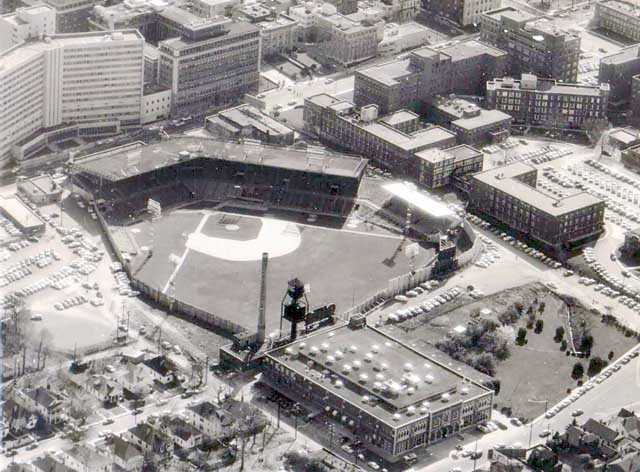
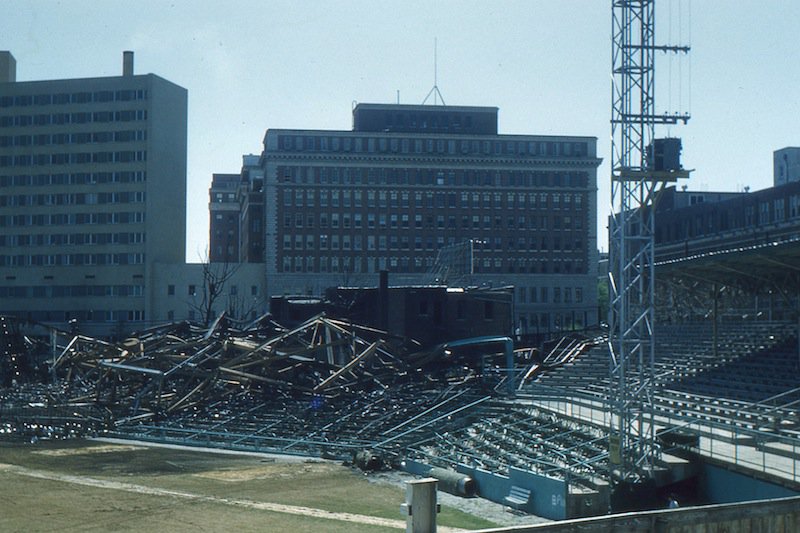

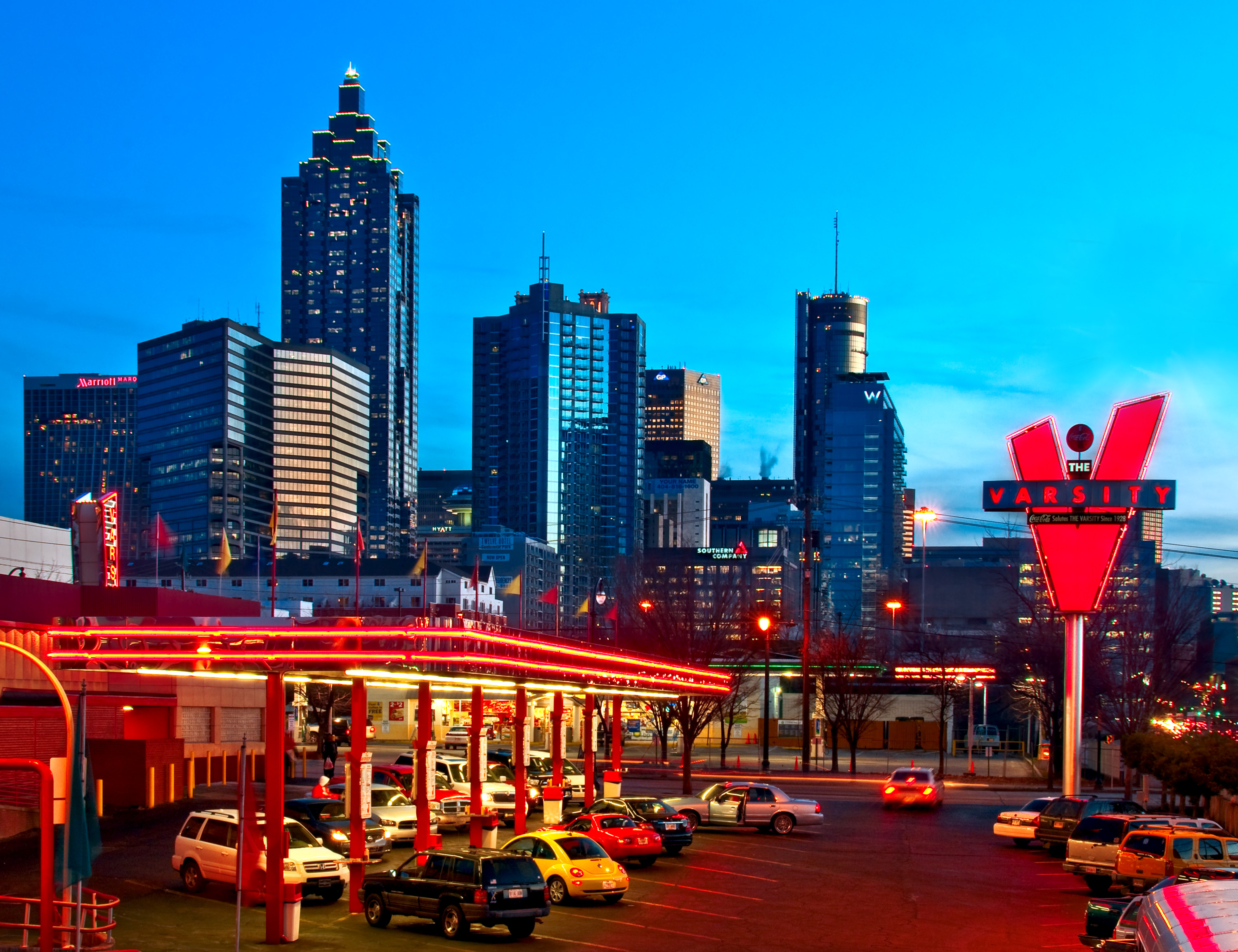


.svg/255px-Flag_of_Georgia_(U.S._state).svg.png)



